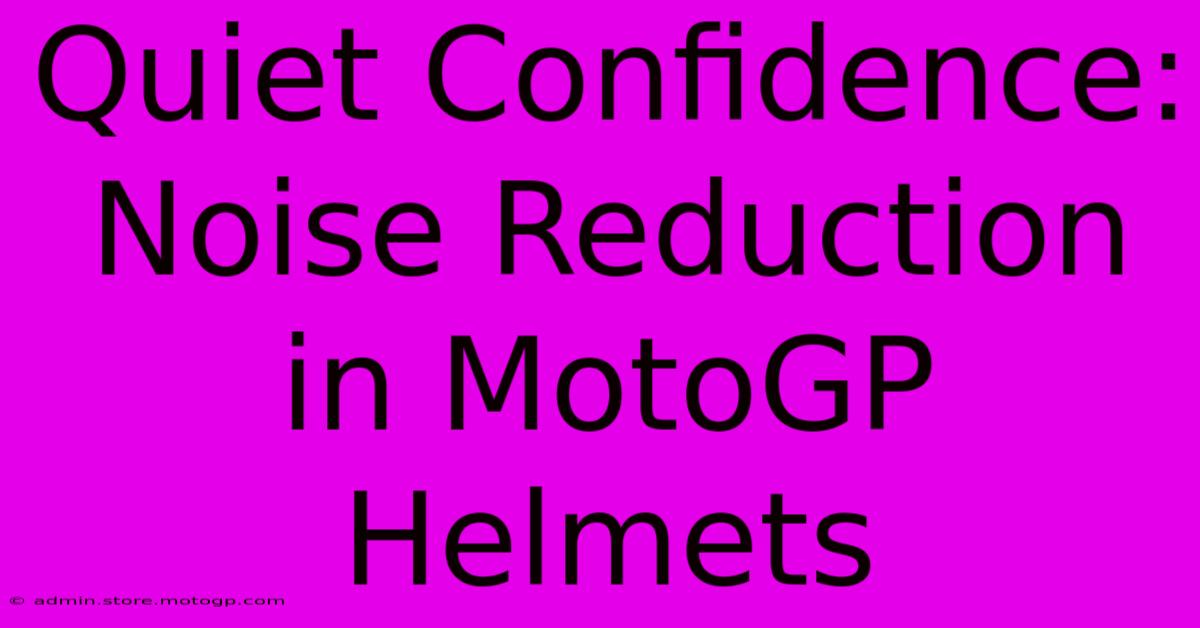Quiet Confidence: Noise Reduction In MotoGP Helmets

Table of Contents
Quiet Confidence: Noise Reduction in MotoGP Helmets
The roar of the crowd, the scream of the engine, the wind whistling past at breakneck speeds – MotoGP racing is a sensory assault. For riders pushing the limits of human performance, minimizing distractions is crucial. This is where the technology behind noise reduction in MotoGP helmets becomes paramount, offering not just comfort but a vital competitive edge. This article delves into the sophisticated engineering and design that goes into creating these incredibly quiet helmets, examining the elements that contribute to a rider's focus and ultimately, their success.
The Importance of Quiet in MotoGP
The relentless noise in MotoGP isn't just annoying; it's a significant impediment to performance. Excessive noise can:
- Impair concentration: Riders need razor-sharp focus to react to changing track conditions, other riders, and their own bike's behavior. Constant loud noise significantly impacts cognitive function.
- Cause fatigue: Prolonged exposure to high noise levels leads to fatigue, both mentally and physically, reducing reaction times and increasing the risk of errors.
- Affect communication: Clear communication with the pit crew is essential. Noise pollution can make radio communication difficult, hindering crucial adjustments and strategies during the race.
- Increase stress levels: The already intense pressure of MotoGP racing is amplified by constant noise, negatively impacting rider performance and well-being.
Engineering Silence: Key Technologies
Manufacturers employ several innovative technologies to minimize noise within MotoGP helmets:
1. Advanced Shell Construction:
The helmet shell itself plays a crucial role. Composite materials, such as carbon fiber, are used for their lightweight yet incredibly strong properties. The carefully engineered shape of the shell is designed to deflect wind and minimize turbulence, reducing noise significantly. Aerodynamic testing plays a vital role in optimizing this design.
2. Acoustic Lining and Padding:
The internal lining and padding are far from standard. Multi-layered materials, often including specialized foams and fabrics, absorb sound effectively. These materials are strategically placed to target specific noise frequencies, further improving noise reduction. The design minimizes air gaps which can act as resonating chambers for unwanted sound.
3. Improved Ventilation Systems:
While ventilation is essential for rider comfort and cooling, it can also introduce noise. MotoGP helmets feature highly engineered ventilation systems with carefully designed intake and exhaust ports that minimize noise intrusion while maximizing airflow. This balance between ventilation and noise reduction is a complex engineering challenge.
4. Chin Bars and Spoiler Design:
The design of the chin bar and spoiler is crucial for managing airflow around the helmet. Optimized shapes minimize turbulence and reduce wind noise, directing air smoothly around the helmet. This is particularly important at high speeds where wind noise is most pronounced.
5. Noise-Cancelling Technology (Emerging):
While not yet universally adopted, some manufacturers are exploring the use of active noise-cancellation technology in MotoGP helmets. This technology uses microphones to detect ambient noise and generates opposing sound waves to cancel it out. This is a cutting-edge approach with the potential to significantly improve noise reduction even further.
The Competitive Advantage of Quiet
The benefits of noise reduction in MotoGP helmets extend beyond rider comfort. Reduced noise translates to:
- Improved reaction times: Sharper focus leads to faster reactions, a crucial factor in overtaking maneuvers and avoiding accidents.
- Enhanced concentration: Maintaining focus over the course of a demanding race is vital. Quieter helmets contribute to sustained concentration, improving performance and consistency.
- Reduced fatigue: Lower noise levels minimize fatigue, allowing riders to maintain peak performance for the duration of the race.
- Better communication: Clear communication with the team means more effective adjustments can be made during the race, optimizing strategy and performance.
In conclusion, the pursuit of quiet in MotoGP helmets represents a remarkable fusion of engineering, materials science, and a deep understanding of human physiology. The technology involved is not merely about comfort; it's a critical factor in determining the success and safety of these elite athletes. As technology continues to advance, we can expect even quieter and more sophisticated helmets in the future, further enhancing rider performance on the track.

Thank you for visiting our website wich cover about Quiet Confidence: Noise Reduction In MotoGP Helmets. We hope the information provided has been useful to you. Feel free to contact us if you have any questions or need further assistance. See you next time and dont miss to bookmark.
Featured Posts
-
Moto Gp Standings Edge Of Your Seat Excitement
Feb 20, 2025
-
Motorcycle Helmet Scams How To Avoid Being A Victim
Feb 20, 2025
-
Red Bulls Grand Prix Strategy Mastering The Race
Feb 20, 2025
-
Race Winning Bikes At Unbeatable Prices
Feb 20, 2025
-
Yamaha Moto Gp Racing The Silent Revolution Team News Insight
Feb 20, 2025
